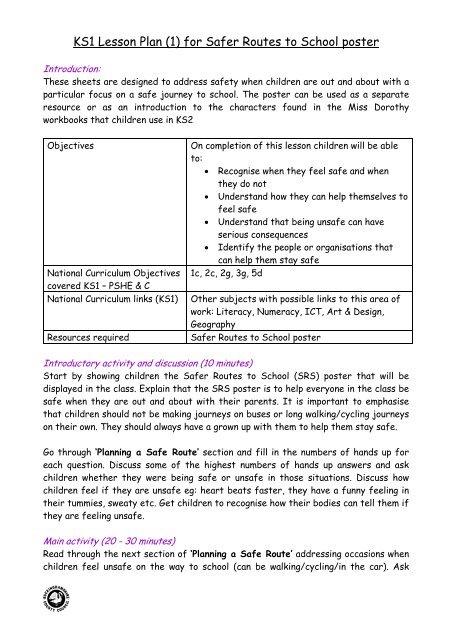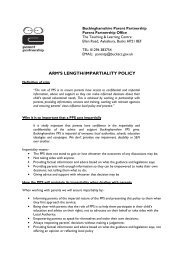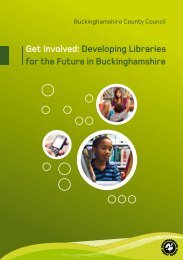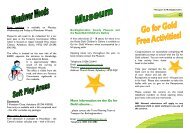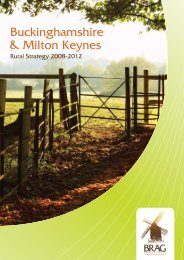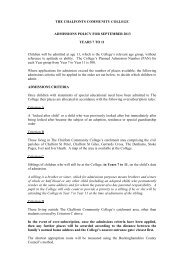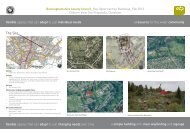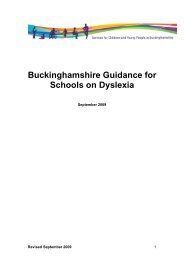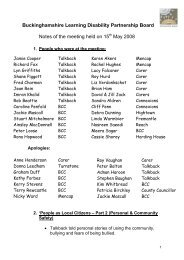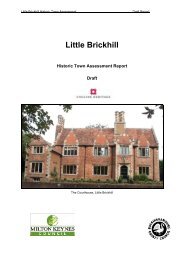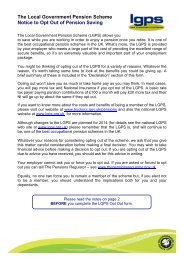Key Stage 1
Key Stage 1
Key Stage 1
You also want an ePaper? Increase the reach of your titles
YUMPU automatically turns print PDFs into web optimized ePapers that Google loves.
KS1 Lesson Plan (1) for Safer Routes to School poster<br />
Introduction:<br />
These sheets are designed to address safety when children are out and about with a<br />
particular focus on a safe journey to school. The poster can be used as a separate<br />
resource or as an introduction to the characters found in the Miss Dorothy<br />
workbooks that children use in KS2<br />
Objectives<br />
National Curriculum Objectives<br />
covered KS1 – PSHE & C<br />
National Curriculum links (KS1)<br />
Resources required<br />
On completion of this lesson children will be able<br />
to:<br />
• Recognise when they feel safe and when<br />
they do not<br />
• Understand how they can help themselves to<br />
feel safe<br />
• Understand that being unsafe can have<br />
serious consequences<br />
• Identify the people or organisations that<br />
can help them stay safe<br />
1c, 2c, 2g, 3g, 5d<br />
Other subjects with possible links to this area of<br />
work: Literacy, Numeracy, ICT, Art & Design,<br />
Geography<br />
Safer Routes to School poster<br />
Introductory activity and discussion (10 minutes)<br />
Start by showing children the Safer Routes to School (SRS) poster that will be<br />
displayed in the class. Explain that the SRS poster is to help everyone in the class be<br />
safe when they are out and about with their parents. It is important to emphasise<br />
that children should not be making journeys on buses or long walking/cycling journeys<br />
on their own. They should always have a grown up with them to help them stay safe.<br />
Go through ‘Planning a Safe Route’ section and fill in the numbers of hands up for<br />
each question. Discuss some of the highest numbers of hands up answers and ask<br />
children whether they were being safe or unsafe in those situations. Discuss how<br />
children feel if they are unsafe eg: heart beats faster, they have a funny feeling in<br />
their tummies, sweaty etc. Get children to recognise how their bodies can tell them if<br />
they are feeling unsafe.<br />
Main activity (20 - 30 minutes)<br />
Read through the next section of ‘Planning a Safe Route’ addressing occasions when<br />
children feel unsafe on the way to school (can be walking/cycling/in the car). Ask<br />
abcde
children how they can change that feeling so they do feel safe. Do they need an adult<br />
to help them feel safe Can they do something to help themselves feel safe<br />
In books or on a larger piece of paper to display as posters in the class or around the<br />
school:<br />
Get children to divide their page/paper in half. On one side write Unsafe and on the<br />
other write Safe. Get children to draw (and write if able) a situation on their way to<br />
school where they feel unsafe and safe.<br />
Optional/Extension activity<br />
Referring to the bottom section of ‘Planning a Safe Route’ section. Do children know<br />
what the game ‘chicken’ is Have they heard or seen anyone do this Allow children to<br />
make open comments about the game before discussing the consequences. Write down<br />
the children’s suggestions about why this is a dangerous game to play.<br />
Optional/Extension activity<br />
Referring to the bottom section of ‘Safety on the Streets’ section. Can children<br />
think of how mobile phones help them stay safe and how they can make you unsafe<br />
Ideas can be drawn or written down depending on the ability of the child.<br />
Plenary (10 minutes)<br />
Discuss with children the ideas that they come up with about how to change an unsafe<br />
situation to a safe one. Ask if they can think of people, other than members of their<br />
family, who can help them stay safe (police, school crossing patrollers, another parent<br />
etc). Referring to the top of ‘Safety on the Streets’ section, complete the poster<br />
with the children’s suggestion for the 4 different situations. Some situations will<br />
require them to get help from other people and some they will have to do things<br />
themselves. For situations that require an adult to help, get children to think of<br />
questions they would ask. Get children to practise asking the questions to each other<br />
so they are confident to do so if needed.<br />
abcde
KS1 Lesson Plan (2) for Safer Routes to School poster<br />
Introduction:<br />
These sheets are designed to address safety when children are outside with a<br />
particular focus on a safe journey to school. The poster can be used as a separate<br />
resource or as an introduction to the characters found in the Miss Dorothy<br />
workbooks that children use in KS2.<br />
Objectives<br />
National Curriculum Objectives<br />
covered KS1 – PSHE & C<br />
National Curriculum links (KS2)<br />
Resources required<br />
On completion of this lesson children will be able<br />
to:<br />
• Recognise when they feel safe and when<br />
they do not<br />
• Understand how they can help themselves to<br />
feel safe<br />
• Understand that being unsafe can have<br />
serious consequences<br />
• Identify the people or organisations that<br />
can help them stay safe<br />
1c, 2c, 2g, 3g, 5d<br />
Other subjects with possible links to this area of<br />
work: English, ICT, Art & Design<br />
Safer Routes to School poster<br />
An item that is reflective<br />
An item that is fluorescent<br />
Map of the local area including the school<br />
Introductory activity and discussion (10 minutes)<br />
Recap on previous lesson and see how much children can recall about what is safe and<br />
what is unsafe. Get children to think about how they get to school. Compile a tally<br />
chart on the board of the different ways that children come to school. Ask children<br />
why they think children come to school in different ways (distance, convenience,<br />
working parents etc). Which is the quickest way to get to school Which is the<br />
healthiest way to get to school Ask children to chose from the categories on the<br />
board, which way they would PREFER to come to school. Discuss the results if they<br />
are different to how they actually travel. Why do more/less children want go in the<br />
car Why do more/less children want to walk or cycle<br />
Look at the number of children who walk or want to walk. Ask the children how they<br />
could walk to school safely. What things would they need What things would make it<br />
too difficult (eg too many bags, musical instruments etc) What things would they<br />
abcde
need to wear Show children the fluorescent item and explain that it is very bright<br />
so drivers can see them very easily. Show children the reflective item and explain<br />
that it is not bright but is made of lots of tiny mirrors so if a light is shone on it, it<br />
looks like a light. Ask children what time of year this would be especially helpful<br />
Main activity (20 - 30 minutes)<br />
Show children a map of the local area and clearly highlight the school. Organise<br />
children into groups of 5-6 depending on where they live in relation to the school (use<br />
pupil address information rather than from childrens’ own account). Use the map to<br />
show children how close or far they are from the school. In their groups children are<br />
to find at least one other person who travels to school the same way as they do<br />
(ideally working in only 2s or 3s). They must then think about how they can help each<br />
other to come to school together eg: walk together, car share, use the bus together.<br />
This is an opportunity for children to find out something new about their classmates<br />
and work together to keep each other safe whilst reducing congestion and keeping<br />
healthy.<br />
Once the children have agreed in their pairs they can draw or write something to tell<br />
the rest of the class what they have decided to do. For children who find they are on<br />
their own in a group see if there are other children in another home location group<br />
that they could work with eg: if they go on a bus together but not live in the same<br />
area. There may be a few children who travel in a unique way to the rest of the class<br />
eg: taxi. These children can either work independently or with another child/pair but<br />
try to encourage them to present their finished work to the class independently.<br />
Plenary (10 minutes)<br />
Get each pair or group to show the class what they have decided to do. Keep children<br />
in their pairs or groups and show them the ‘journey to school’ section of the poster.<br />
Ask each question posed in this section and get children in their pair/3s to come up<br />
with an answer together. The teacher can complete answers on the poster to<br />
consolidate the learning. Particular attention should be made to the numbers needed<br />
in an emergency (999 and their own phone number) and any other information they<br />
may need to give (home address and any medical needs). Get children to practise<br />
telling each other these pieces of information so they are confident to give correct<br />
information. If children are not confident it may be necessary to set this activity as<br />
homework.<br />
abcde
Assessment opportunity:<br />
Photocopy the section ‘staying safe’. Give children a copy and allow them to complete<br />
the section without teacher input.<br />
most children will be able to:<br />
some children will not have made so much<br />
progress. They will be able to:<br />
explore ideas about road safety; say what they think and feel about<br />
when they are safe or unsafe; discuss and use drawing or written work<br />
to communicate their ideas about how they travel to school; suggest<br />
ways of combining their journey to school with someone else.<br />
use drawing or written work to communicate ideas about road safety;<br />
talk about what they think or feel about how they travel to school.<br />
some children will have progressed further. They<br />
will be able to:<br />
incorporate more complex ideas or individual idea into their<br />
understanding of road safety; apply their road safety knowledge to<br />
situations not addressed as a class; consider how to change how they<br />
travel to school to reduce congestion or improve health; comment on<br />
similarities and differences in their own ideas and those of others.<br />
Further extension:<br />
The topics and discussions used over the course of these two lessons can easily be<br />
used to form the basis of an assembly on Road Safety and Safer Routes to School<br />
issues. An assembly provides an excellent opportunity to address these issues with<br />
the whole school and most importantly with parents/carers. You may even wish to<br />
invite a local policeman or school crossing patroller to say a few words to support the<br />
work the children have done in the lessons.<br />
abcde
Road accident casualties 1994 - 2004<br />
1994 2004<br />
Child pedestrians<br />
Killed 160 77<br />
Killed or seriously injured 4 610 2 339<br />
All severities 19 263 12 234<br />
Pedestrians (child & adults)<br />
Killed 1 113 666<br />
Killed or seriously injured 12 724 7 344<br />
All severities 47 392 33 638<br />
Child pedal cyclists<br />
Killed 42 25<br />
Killed or seriously injured 1 234 577<br />
All severities 8 075 4 682<br />
Pedal cyclists (child & adults)<br />
Killed 171 134<br />
Killed or seriously injured 3 944 2 274<br />
All severities 24 172 15 048<br />
Car drivers and passengers (child & adult)<br />
Killed 1 764 1 671<br />
Killed or seriously injured 23 892 16 144<br />
All severities 195 154 183 858<br />
Bus/coach drivers & passengers (child & adult)<br />
Killed 21 20<br />
Killed or seriously injured 815 488<br />
All severities 10 090 8 820<br />
Data supplied from RoSPA (The Royal Society for the Prevention of Accidents)<br />
abcde


